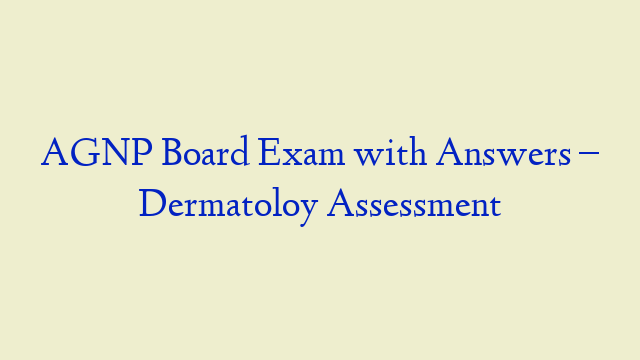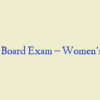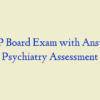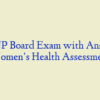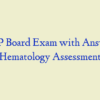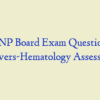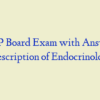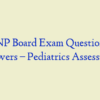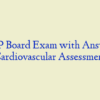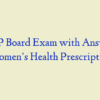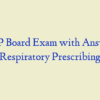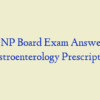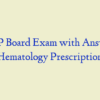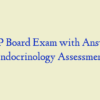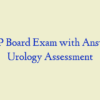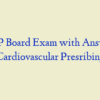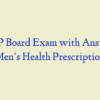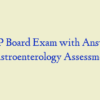Description
AGNP Board Exam Questions Dermatoloy (64 Questions and Answers)
- A reddish blue, irregularly shaped, solid and spongy mass of blood vessels that may be present at birth and enlarge during the first 10 to 15 months is characteristic of a:
- A chancre is define as a:
- Transverse depressions of the nail plates, usually bilateral, resulting from temporary disruption of proximal nail growth from systemic illness is termed:
- A child has a maculopapular, blotchy rash and on examination of his mouth, red eruptions with white centers on the buccal mucosa are visualized. These eruptions are call:
- When examining the external genitalia of a female patient, excoriations and itchy, small, red maculopapulares were noted. This lesions may be suggestive of:
- A 75-year-old man presents with several brown, raised, slightly greasy peeling, velvety appearing lesions on the trunk. These lesions would be classified as:
- When assessing the skin, it is noted to be thickened, taut, and shiny in appearance. This could be associated with:
- The term asteatosis refers to:
- The assessment findings of the integumentary system of an 80-year-old that would warrant further evaluation would include:
- The patient has recently sustained an injury to the upper thigh. Examination reveals an irregular shaped purplish blue lesion that does not blanch with pressure and does not exhibit pulsatility. This would be consider:
- A patient is observed to have pressure related alteration of intact skin along with changes in temperature, consistency, sensation, and color. Which stage of pressure ulcer is consistent with this?
- Examination of a child who experienced a burn from a curling iron on the forearm appears red without blistering but is painful to touch.This type of burn would be classified as a:
- The term use to describe dark-color adherent crust of dead tissue around an ulcer is:
- Skin conditions such as pruritus, hyperpigmentation, and calciphylaxis may be seen in patients who have:
- An adolescent is being examined for acne and findings revealed several closed comedones. These findings are also term:
- A child was involved in a vehicular accident and sustained burns on the lower extremities.
- Examination reveals a dry, waxy, whitish appearance of both lower legs and some visualization of the tibialis anterior. This type of burn would be classified as a:
- Lesions that develop within hair follicles produce papules that become erythematous, and painful are term:
- When assessing the skin, it is noted to be very dry and cool to touch. This could be associated with:
- A patient presents with a full thickness tissue loss with exposed bone and tendon and eschar of the left hip. Which stage of pressure ulcer development is this?
- Striae, skin atrophy, and purpura may be associate with:
- When the examiner lifts a fold of skin and notes how quickly it returns to place, the examiner is assessing skin:
- A six-year-old child presents with a few small vesicles that are honey-colored and weeping around the left nare. These lesions are consistent with:
- To assess skin temperature, the examiner would use the:
- A priority intervention in caring for a child diagnose with atopic dermatitis should be to:
- Which stage of pressure is consistent with findings on dermatologic examination of a full thickness tissue loss and subcutaneous fat visible with mild slough on the right hip?
- When suspecting pediculosis capitis, the chief complaint is:
- Examination of the nail beds revealed pitting in the nail. This is consistent with:
- When assessing the skin, it has a velvety appearance and is warm to touch. This could be associate with:
- A yellowish hue imparted to the skin, mucous membrane, or eye is term:
- A child presents with erythematous papules and vesicles, that are weeping, oozing, and crusty. These lesions are located over the forehead, wrists, elbows, and the backs of the knees. With which of the following conditions are these symptoms associate?
- Pressure ulcers, decubitus ulcers, develop over all of the follow body parts except the:
- The term used to describe skin that is red over the entire body is:
- A raised, crusted border with central ulceration on the helix is identified. This lesion needs further evaluation because it is most likely:
- A patient has a papule with an ulcerated center on the lower lid and medial canthus of the eye. This is consistent with:
- Depigmented macules appearing on the face, hands, feet and other parts of the body due to the lack of melanin are termed:
- An example of a macule is:
- Granuloma annulare, acanthosis nigricans, and candidiasis may be seen in patients who have:
- A child sustained a “full-thickness” burn injury. This type injury involves tissue destruction down to the:
- When examining the skin, multiple areas of circumscribed elevations of the skin filled with serous fluid measuring approximately 0.5 cm were note. These types of lesions could be seen in:
- An infect area of the thigh was edematous, erythematous, tender, and warm to touch. The skin was blistering but free from exudate and the patient’s temperature was 102 °F. This is suggestive of:
- Ticks can transmit and cause:
- When examining the left ear, a raised nodule behind the ear is note to have a lustrous surface with visible telangiectatic vessels in the center. This lesion needs further evaluation because it is most likely:
- Verruca plana is define as:
- When assess the skin, silvery, scaly papules or plaques are note on the extensor surface of both arms. This could be associate with:
- A small child sustained burns to the posterior trunk and posterior surface of both arms. According to the “Rule of Nines” for small children, what percentage of the total body surface area was involve?
- When the term rubor is use in describing the skin, it means that the appearance is:
- When examining a patient with atopic dermatitis, there is a thickening and roughening of the skin with increased visibility of the normal skin furrows. This condition is termed:
- Hairy leukoplakia may be associate with:
- A child received a burn to the chest from a cup of hot coffee. On examination, the injured area appears moist and red to ivory white in color, blisters are note, and painful to touch. This burn would be classified as a:
- A 45-year-old male presents with a skin lesion that has a smooth, slightly scaly, or pebbly surface, with an irregular edge. Further evaluation reveals a dark brown 2.5 cm lesion. This is most likely a:
- A forty-year-old man presents with a slow growing lesion on the face. Further examination reveals a lesion with a depress center, a firm elevated border, and visible telangiectatic vessels. This is most consistent with:
- An inflammation of the proximal and lateral nail folds represents:
- A patient presents with a fiery red, slightly raise 2 cm lesion on the upper truck that blanches when pressure is applied. The body of the lesion is surrounded by erythema and radiating legs. This is most likely:
- Which model is use to designate risk factors for melanoma?
- Skin lesions that appear hypo or hyperpigmented with slightly scaly macules on the trunk, neck, and upper arms are likely:
- Which stage of pressure ulcer is consistent with a partial thickness loss of the dermis presenting as a shallow open ulcer with a red pink wound bed, without slough?
- An infant presents with a rash in the diaper area. Which description likely indicates candidal diaper rash?
- On examination, a white discoloration appearing on nails was note. This is consistent with:
- If a lesion is describe as annular, it appears:
- A slow, persistent fungal infection of fingernails and toenails is:
- A dark, raised, asymmetric lesion with irregular borders may be:
- The term used to refer to skin that is peeling is:
- Asymmetry, irregular borders, variation in color, diameter greater than 6 mm, and elevation represent the “ABCDEs” of:
- Purple patches or macules on backs of the hands and forearms of the elderly would be suggestive of:
